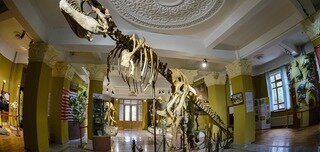Museums
Museum of Nature
Museum of Nature consists of paleontological and zoological collections, which illustrate changing nature of Kazakhstan from ancient times to the present day. The pride of the museum is the skeleton exposition of giant rhinoceros, mammoth and six-meter skeleton of Tarbosaurus - congener carnivorous dinosaur.
The museum is unique with exposition that shows the fossils, skeletons and stuffed animals, which lived exclusively on the territory of Kazakhstan.
The idea to open such museum in Kazakhstan was appeared in the early 50s of last century, and supported by the first president of the Kazakh SSR Academy of Sciences, academician K.Satpaev. The museum had begun to take first visitors since 1959, and gradually gained wide popularity in Kazakhstan and abroad. The official opening of the museum, in accordance with the Decree of the Presidium of the Academy of Sciences of the Kazakh SSR on 29 April 1961, № 44, was dedicated to the 40th anniversary of the Kazakh SSR.
Results of paleontological studies reveal the chronology of the evolution of the animal world. During studying pages of the stone chronicle of the Earth's interior step by step, scientists restore landscapes of the geologic eras of the Phanerozoic (from 570 million years until the present day), which present a major interest for understanding of the history formation of modern flora and fauna of the Northern Hemisphere, including Kazakhstan.
It should be noted that after discovery of the skeleton of giant rhinoceros in 1912, dozens of scientific discoveries were made that brought international fame to Kazakhstan as a unique country for paleontological research. Due to geographical position, the size of the territory and diversity of landscapes, Kazakhstan is characterized by variety of wildlife from the prehistoric era to the present day.
After creation Zoology sector from 1932 to 1958, scientists of the Institute of Zoology (The Academy of Sciences of the Kazakh SSR) were collected and studied scientific data about the wildlife of Kazakhstan. These collections were remains of ancient prehistoric animals that collected by scientists -paleontologists and geologists in Turgay, Zaisan and Central Kazakhstan in 1948-1957, which gave an idea to open a museum. During 50 years, the museum had gained wide popularity in Kazakhstan and abroad due to scientific- educational and environmental directions.
In 2010, after a long-term repair work began the restoration works on exposition of the Museum of Nature in the system of the Republican State Enterprise "Gylym Ordasy" of the Committee of Science, Ministry of Education and Science of the Republic of Kazakhstan.
The paleontological exhibition hall has operated since 2012, which began the work on creating a zoological exhibition hall. The paleontological exposition of the museum had restored and significantly updated in middle of the 2012. Newly restored and renovated the skeleton of a giant rhinoceros, steppe and wetland rhinoceros, mammoth, three-toed horses and horses- hipparions. New exhibited materials are on stands and individual expositions. The exposition is complemented with colorful wall reliefs, stands of the evolution of animals, relief map of the spread ancient animals on the territory of Kazakhstan.
The main purpose of the museum is popularization of the Kazakhstan fauna from the simplest to the highly organized creatures from ancient geological ages to the present day.
The basis of the paleontological museum exposition is a few perfectly preserved artifacts. The six-meter skeleton of Tarbosaurus meets first guests of the museum, who a close relative of the carnivorous dinosaur - Tyrannosaurus Rex that lived in the territory of Asia.
The skeletal remains of Tyrannosaurus Rex were found in the 70-ies of the last century in the Central region. According to agreement with Moscow colleagues-paleontologists, the copy of Tarbosaurus was made, and now it decorates the Museum of Nature.
Museum visitors have an opportunity to compare the skull of a giant rhinoceros with skull of modern animals, and to be sure that ancestors were twice bigger. The museum presents a female giant rhinoceros, which has a height of six meters.
One of the halls presents a real monster - crest-teethed ishim mastodon of the Neogene period, the length of the tusk is more than four meters.
Visitors can also see the charming family of tapirs that lived 60 million years ago. Next - a powerful ancient pig-shaped entelodons, who lived near the Shalkhar Lake in the Torgay cavity 32 million years ago.
The museum has a unique finding - a big pile of fossilized turtle, which died in hibernation. These turtles were found in 1985, in Semipalatinsk Priirtysh near the salt lake Karabastuz.
Findings (skull and jaw) of brontothers, which made together with American scientists, are considered as a unique in the museum, because artists first depicted this animal specifically for the museum. And later, there was a real miracle- remains of it were found in the Aktau Mountains!
The museum regularly provides internships for professionals and trainings for students on special courses with the use of visual materials in historical geology and ancient animals, Helminthology and Parasitology, on the protection of nature. Tours are conducted by museum, and it has a great awareness and education for schoolchildren and tourists.
- Tell your friends:
 Подробнее
Подробнее
Museum of Nature
Other Museums

Museums
Almaty Railway Museum
Almaty Railway Museum is one of the largest technical museums in Kazakhstan. History of the museum began in 1999, when the personal collection of the railroader veteran Beisen Shormakov organized a small departmental museum. It was located in the former of Turksib Office, which was the architectural monument.

Museums
Republican Museum of Sports and Olympic glory
Republican Museum of Sports and Olympic glory is located in one of the oldest buildings in Almaty. The house stands in the center of Almaty over 160 years. It was built in the middle of the XIX century.







